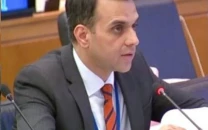Solar power shift could inflate non-solar bills
Initiative deviates from federal govts policy, which aims to retain users on national grid

As the Punjab Government launches an ambitious and costly project to provide solar units to around five million users, experts warn that non-solar consumers may face inflated bills.
The provincial initiative deviates from the federal governments policy, which aims to retain users on the national grid.
Critics argue that non-solar users will face higher bills, as they will be forced to pay capacity charges for each reduced unit consumed.
The provincial government is finalising plans to offer complete solar arrays to consumers using between 200 and 500 units, as well as to lifeline consumers.
Currently, the first group of consumers does not enjoy special exemptions like lifeline consumers, meaning they share a load of protected consumers along with medium to high-end users.
With these consumers shifting to solar, their grid consumption will plummet, transferring the capacity payment burdenwhich exceeds two trillion rupees this fiscal yearonto those remaining on the national grid.
Reports indicate that capacity payments constitute 70 per cent of the unit price, potentially leading to significantly higher costs for non-solar users.
Speaking to The Express Tribune, experts supported the provincial project, acknowledging minor procedural issues but agreeing that it will help lower-middle-class families manage rising electricity costs.
However, they emphasise the urgent need to address the capacity payment issue, warning that failure to do so will eventually increase unit prices to satisfy power producers.
Economist Qais Aslam explained that as consumers leave the grid or switch to reserve metering, supply from Independent Power Producers (IPPs) will decrease, raising unit prices for non-solar users. He also highlighted concerns about the federal governments stance, fearing potential discouragement of solar power.
Aslam suggested that the government buy out and divest IPPs to mitigate these issues.
Other financial experts echoed the sentiment that shifting consumers off the grid will pressure those reliant on it. However, Ali Khizer argued that increased solar adoption could lower unit costs by reducing cross-subsidies for protected consumers, thus benefiting all users.
Provincial Minister for Information Azma Bukhari, speaking to The Express Tribune, said that the notion of the federal government trying to discourage solarization is a misconception.
She emphasised that the government fully supports solar power, a position clarified multiple times by federal authorities. When asked about the potential added burden on non-solar users, she described it as a technical matter outside her current knowledge.
Regarding the provision of green meters to eligible consumers under the scheme, she also indicated that this, too, was a technical matter she was not aware of at the time of the conversation.



















COMMENTS
Comments are moderated and generally will be posted if they are on-topic and not abusive.
For more information, please see our Comments FAQ